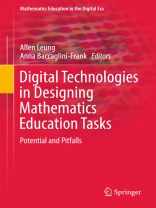This book is about the role and potential of using digital technology in designing teaching and learning tasks in the mathematics classroom. Digital technology has opened up different new educational spaces for the mathematics classroom in the past few decades and, as technology is constantly evolving, novel ideas and approaches are brewing to enrich these spaces with diverse didactical flavors. A key issue is always how technology can, or cannot, play epistemic and pedagogic roles in the mathematics classroom. The main purpose of this book is to explore mathematics task design when digital technology is part of the teaching and learning environment. What features of the technology used can be capitalized upon to design tasks that transform learners’ experiential knowledge, gained from using the technology, into conceptual mathematical knowledge? When do digital environments actually bring an essential (educationally, speaking) new dimension to classroom activities? What are some pragmatic and semiotic values of the technology used? These are some of the concerns addressed in the book by expert scholars in this area of research in mathematics education. This volume is the first devoted entirely to issues on designing mathematical tasks in digital teaching and learning environments, outlining different current research scenarios.
Spis treści
Introduction by Allen Leung and Anna Baccaglini-Frank.- Section One.- Chapter 1 How the software used affects task design: Kate Mackrell and Christian Bokhove.- Chapter 2 The historical development of Digital Mathematics Environment: Peter Boon and Paul Drijvers .- Section Two.- Chapter 3 Techno-pedagogic task design in mathematics: Allen Leung.- Chapter 4 How the software design can affect students’ mathematical productions: Samuele Antonini, Anna Baccaglini-Frank, Allen Leung, Maria Alessandra Mariotti.- Chapter 5 Using variation and feedback in tasks to increase learning: Christian Bokhove.- Section Three.- Chapter 6 Design digital tasks: Interactive Diagrams as resource and constraint: Michal Yerushalmy & Elena Naftaliev.- Chapter 7 E-books and Lesson Study: a teaching experiment on intercultural dialogue: Masami Isoda, Maria G. Bartolini Bussi, Alessandro Ramploud.- Chapter 8: What can you infer from this example? Applications of online, rich-media tasks for enhancing pre-service teachers’ knowledge of the roles of examples in proving: Orly Buchbinder, Iris Zodik and Gila Ron.- Section Four.- Chapter 9 Issues emerging from the experiences of designing microworlds for young children: Anna Baccaglini-Frank.- Chapter 10: Designing tasks for the social and tangible mathematics in Touch Counts : Nathalie Sinclair.- Chapter 11 Designing digital mathematics learning scenarios for a more inclusive school mathematics:Lulu Healy and Solange Hassan Ahmad Ali Fernandes.- Chapter 12 Designing innovative learning activities to face up to difficulties in algebra of dyscalculia students: how exploit the functionality of Al Nu Set: Elisabetta Robotti.- Section Five.- Chapter 13 Role and potential of using an interactive whiteboard and the relationship with teachers’ practices: Floriane Wozniak.- Chapter 14 Designing assessment tasks in a dynamic geometry environment: Nathalie Sinclair and Marta Venturini .- Chapter 15 Designing tasks to promote discoursein math classroom: Janete Bolite Frant, Andreia Maciel Barbosa, Wellerson Quintaneiro.- Chapter 16 Designing for mathematical applications and modelling tasks in technology rich environments: Vince Geiger.- Section Six.- Chapter 17 Tensions in the design of mathematical technological environments: Tools and Tasks: Alison Clark-Wilson.- Chapter 18 The Learning by Design paradigm for Mathematics Teaching: Eugenia Koleza, Eugenia Arvanitis.- Chapter 19 Feedback and didactical variable in the design of task with Cabri Elem technology: Sophie Soury-Lavergne and Michela Maschietto.












